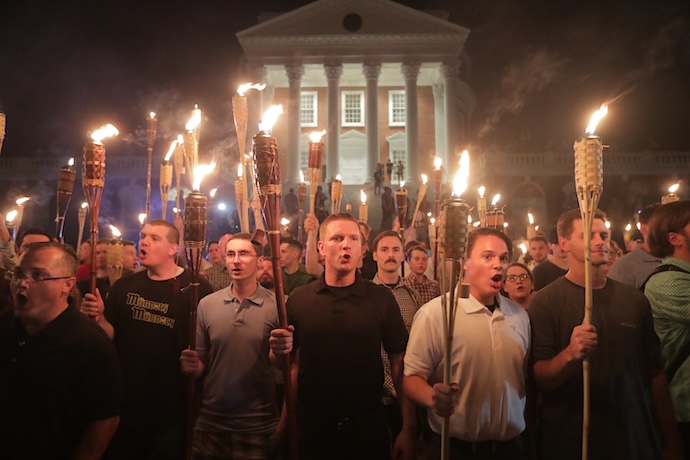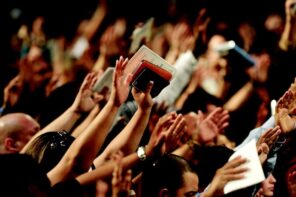When the Anti-Defamation League’s (ADL) annual Antisemitism Audit was released in April, its claim of a 140% rise in antisemitic incidents in 2023 seemed like old news. Following the October 7th Hamas attack that killed nearly 1,200 Israelis, news reports frequently mentioned escalating American antisemitism. Many of these are well documented and unequivocal incidents: street attacks on visibly Jewish people, bomb threats at synagogues, and a return of rhetoric like “Zionist Occupied Government.” But looking more closely at the coverage, these narratives believe one particular type of antisemitism is of paramount importance.
The ADL over the past year has been ringing the warning bell about Jewish Voice for Peace (JVP) and Students for Justice in Palestine (SJP), going as far as demanding police disrupt the protest encampments at Columbia University and elsewhere that sought to pressure institutions to divest from companies profiting from Israel’s war. The ADL’s rationale is that anti-Zionism is antisemitism, an argument that would, if true, implicate the entire Palestine solidarity movement (not to mention many Jews today and throughout history).
Many of the loudest media figures agreed. And not merely the expected sources, like the Free Press’ Bari Weiss, who lamented the “rising wave of antisemitism and illiberalism [that] have swept the country.” In the Atlantic, Franklin Foer asserted that the age of Jewish prosperity and safety was over, while Dara Horn suggested that campus protests were a victory lap for antisemites.
As Israel’s war on Gaza progressed, college presidents were dragged into congressional hearings, more than 3,000 campus protesters were arrested or detained, and congress summarily passed a resolution codifying a particular understanding of antisemitism into law. The ADL got what it wanted: anti-Zionism was now—at least according to the established voice on the subject—antisemitism.
But even as antisemitism remained in the headlines, often diverting attention from what experts call a genocide in Gaza, the ADL’s efforts have ironically diverted attention from where the evidence currently points: there is an antisemitism explosion, but it’s not largely found in left-wing criticism of Israel. We can surely find examples in those spaces, but the crisis is firmly located on the Right: in fascist Telegram chats, among online far-right pundits, and even in the ranks of the GOP. Figures like Nick Fuentes are mainstreaming the “Jewish Question,” making this common element of the fascist Right accessible to a new type of Republican. As a result, suspicion of Jews isn’t as taboo as it once was.
Competing visions for Jewish safety
Modern “anti-antisemitism” approaches emerge from a centrist tradition spearheaded unsurprisingly, by the ADL. Founded in 1913, the ADL was one of several institutions created by more affluent American Jews, largely of German descent, who wanted an advocacy model separate from the radical leftism of their rowdy, Eastern European counterparts. Antisemitism was a clear and present threat, but the ADL, which placed its hope in America’s liberal democracy, also saw political tumult itself as unsafe for Jews.
So instead of the Left, they would work with law enforcement, collaborate with governments, and approach antisemitism as a product of radicalism itself. From its perch in the center, the ADL saw the Left and Right as more or less equal offenders. But antisemitism plays a considerably different role in these competing worldviews which is a primary reason for the disparities in frequency and tendency toward violence we see today.
The history of antisemitism isn’t just a story of anti-Jewish ideas, but a history of reactionary political thought itself. As Christianity became hegemonic in Europe, antisemitism emerged to help create a supremacist, separatist consensus that treated Jews as a particular type of other. This is a foundational part of what renowned political scientist Benedict Anderson called “imagined communities,” in which a nation’s dominant population defines themselves by who they are not. In Europe the Jews were the obvious Other.
This dynamic, which forms the second pillar of the far-right worldview—identifying a safety valve for class anger and social dislocation—was an easy call. Because Jews were, for a variety of reasons, sometimes forced into economic middle-men roles, the notion that this Jewish Other was responsible for the modern world became a way to rechannel the legitimate anger of the masses.
It wasn’t that the rich created a system that exploited your labor, it was all due to these Jewish interlocutors destroying your national community, traditional folkways, and leaving you financially destitute in the process. This was the source of the turn-of-the-century pogroms, culminating in European fascism and the Holocaust. While some have employed antisemitic stereotypes in critiquing capitalism, antisemitism was never central to Leftist ideology.
The Left’s antisemitism often took the form of accepting anti-Jewish stereotypes, denying Jewish peoplehood or religious rights, or invisibilizing Jewish trauma—but it never became as systematized or lethal as the Right’s antisemitism. There are historic instances of violence perpetrated by the Left—often when leftists descended into the same conspiratorial populism found on the Right—but the frequency pales in comparison, and there’s been no incident of mass antisemitic violence from a left-wing movement in generations.
As open antisemitism became less acceptable, the idea that an evil cabal was secretly exploiting the working class majority with equal parts financial schemes and social liberalism became a key pillar of the right-wing appeal to blue collar interests. During the 1960s, while figures like William F. Buckley were celebrated for allegedly expelling antisemites from the Conservative Movement, scholars like John S. Huntington and David Austin Walsh have shown that antisemitism was always part of the Right’s repertoire. Whether in the mid-century propaganda of the Red Scare, or today’s hysteria over “cultural Marxism,” antifa, or Jewish space lasers, this framework is essential to the Right’s popularity and success.
This is the intellectual structure of the National Conservative and MAGA movement’s populism, requiring conspiracy theories that place blame on (((certain people))) while leaving untouched the systems of deregulated capitalism that actually bear responsibility for their misfortune. As a 2023 study showed, a propensity for conspiracy thinking and totalitarian political ideas are most closely correlated with antisemitism—two constituencies that aren’t just prevalent on the American Right, but central to the National Populism that now serves as its motivating ideology.
Because of its volatility and bigotry, the frequency of right-wing violence (up to and including lethal violence) outpaces the Left by such a wide margin that in a healthy media environment there would be no temptation to compare. Just as antisemitism and “eliminationist” rhetoric were central to the Holocaust and European fascist movements, they’ve likewise been central to the Ku Klux Klan, neo-Nazis, skinheads, and today’s alt-right and emerging Dissident Right. With superficial variations in different eras and cultures, all agreed on the basic outline: the Jews are the parasite rending modern society rotten, and the only solution is quarantine or removal.
When Robert Bowers entered the Tree of Life synagogue in 2018, he wasn’t shouting “from the river to the sea” before he opened fire, he was railing against an alleged global Jewish plot to destabilize the White race through non-White immigration. When looking at a list of attacks on American Jews and Jewish institutions, White nationalism is the most indicted ideology (with ultra-conservative forms of Islamism coming second).
The data do not show what you think they show
As economic instability and climate change worsen social conditions, the political center has largely fallen out and the Right has responded by pivoting even further into populism. The increasing centrality of Christian nationalism to the Right’s base will only accelerate this trend towards conspiracism and Jewish erasure. In fact, we’re already seeing antisemitism function as a centerpiece of the Right’s political project, either in coded forms through ideas like the “Great Replacement” conspiracy theory, or in explicit forms found amongst neo-Nazis.
“We find overt antisemitic attitudes are rare on the left but common on the right,” wrote Eitan Hersh and Laura Royden in their 2023 study analyzing antisemitism “across the ideological spectrum.” This is consistent with the findings of just about every other recent study. Christian nationalism remains the most important far-right constituency in the US by size, and, as a recent study by PRRI shows, those with Christian nationalist sympathies are far more likely to hold antisemitic beliefs than the general public. The Right’s vision of nationalism is a natural fit due to its preference for the majority—whether racial, ethnic, or religious.
In 2022, Tel Aviv University revealed that the top distributors of antisemitic propaganda were fascist groups like White Lives Matter and the Folkish Resistance Movement, and more broadly that the “significant increase in antisemitic propaganda distributions in 2022 [accorded] with an overall rise in white supremacist propaganda distributions.” Echoing so many others, the major movements indicating a threat to Jews in the Tel Aviv University report came from the election of far-right parties in places like Europe and Japan, not from the Left’s anti-war movements.
The ADL’s Antisemitism Audit made headlines for showing an alleged spike in antisemitism related to left-wing Palestine protests, but in fact even their data reveal something entirely different. The overwhelming majority of incidents come from White nationalist groups, like the hundreds of incidents from the neo-Nazi Goyim Defense League. The ADL even undercounts far-right antisemitic incidents by using a more restrictive system of classification for White nationalists than for anti-Zionist protesters, despite the available data saying that open neo-Nazi groups, who put the greatest emphasis on Jews, are growing rapidly.
And, when we unpack the data, we find that many of the alleged left-wing antisemitic incidents fail to reflect a consensus understanding of antisemitism and pale in comparison to those found on the Right. Many incidences of antisemitic rhetoric from far-right media and political figures are altogether missing from the data, as are the statements of so-called “pro-Israel” far-right movements including Christian Zionists, many of whom support Israel as part of an eschatology that ultimately demands Jewish conversion or death.
All of this puts the Right’s antisemitism into the proper context for comparison with the Left. Despite the fact that, as noted earlier, incidents on the Right are both more common and of a far more serious nature, it isn’t just a question of who’s most morally consistent or even just where its frequency lies, but of where antisemitism is most entrenched and ideologically key.
And as we’ve seen in White nationalism’s more recent manifestations—from the alt-right to the “Dissident Right”—antisemitism is gaining currency as the old “Judeo-Christian” Cold War consensus dissolves, a revolutionary form of Christian nationalism emerges, and the ideological distance between the fringes and the GOP is almost nonexistent. It’s no coincidence we’re seeing an increase in the size and reach of the far-right when a figure like Nick Fuentes, whose strong following enables him to make a living through streaming services and rogue platforms—even when targeted by antifascists or censorious media companies—is gaining influence.
Naturally, right-wing punditry was among the first places for the antisemitism taboo to disappear. Shortly after October 7, Tucker Carlson suggested that pro-Israel voices are perpetrating “white genocide” in the US; that, in other words, Jews are orchestrating non-White immigration to replace White Christians.
In fact, when he made these comments Carlson was talking with Candace Owens, a conspiracy theorist who once tweeted the groyper-friendly phrase “Christ is King,” and asked a rabbi if he’d “drunk the Christian blood again,” before decrying “political Jews” in Hollywood and DC who “shield themselves from any criticism” by disingenuously leveling antisemitism accusations. The entire #BantheADL campaign popularized by Elon Musk as part of a months-long antisemitic screed was invented by far-right activist Keith Woods. While the ADL is often criticized by the Left for being too conservative, the Right now sees it as too antifascist (or perhaps just too Jewish).
This discourse filtered into electoral politics, where politicians are openly sharing antisemitic conspiracy theories. The “Great Replacement Theory,” for example, has become a common feature of Republican debates, something expressed by Congresswoman Elise Stefanik (who, incidentally, manufactured a media spectacle by accusing several university presidents of antisemitism), and former Speaker of the House Kevin McCarthy who tweeted his concern that three Jewish political candidates were controlled by George Soros.
Republican presidential candidate Donald Trump has a long history of antisemitic comments, such as calling Jews “negotiators” and claiming that Democratic Jews show “great disloyalty.” But these comments didn’t set the bar for acceptable opinions on Jews as loudly as his dinner with Ye and Fuentes. Indeed, major GOP figures like Marjorie Taylor Green (known for her concern about Jewish space lasers) and Paul Gosar (who has shared antisemitic websites) both spoke at Fuentes’ conference.
Even the GOP’s new House Speaker Mike Johnson believes the US is a ‘Christian nation,’ which poses a direct threat to Jews as well as other religious minorities. At the state, county, and precinct level, right-wing antisemitism has only become more severe, while going largely unchallenged.
There have been other reasonable criticisms of the ADL’s methodology, but what’s indisputable is that antisemitic incidents have risen; that White nationalist and neo-Nazi activity is currently at an unprecedented high; and that there’s a clear antisemitic edge to many of the Right’s anti-LGBTQ, anti-abortion, anti-feminist, and anti-immigrant movements. As both the data and the history of antisemitism make crystal clear, this should come as a shock to no one.





